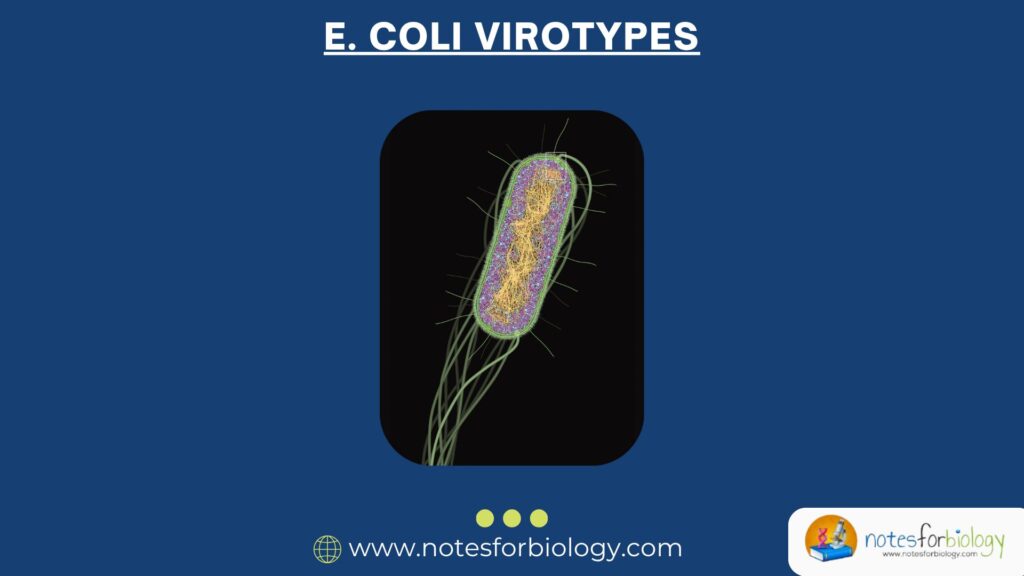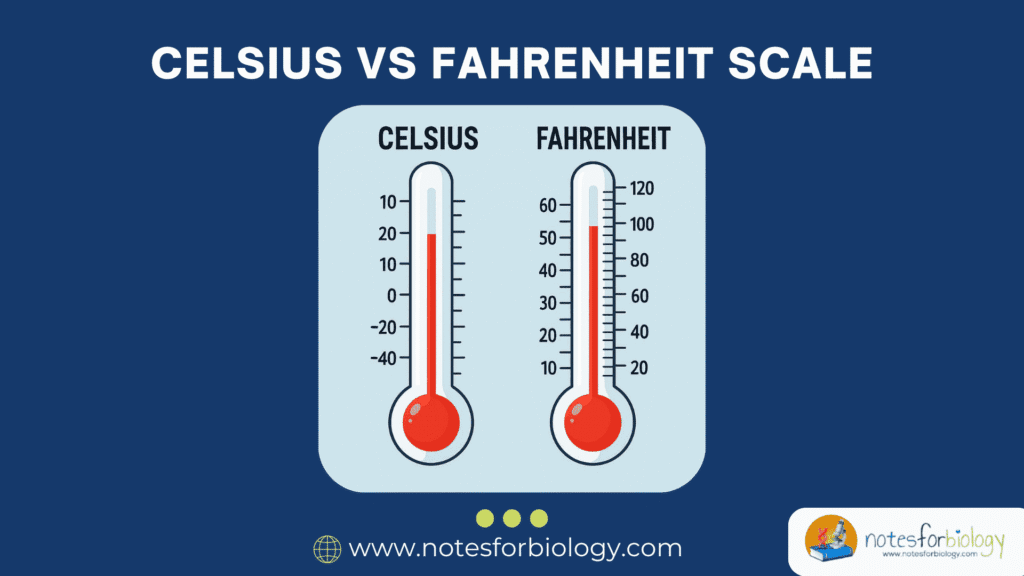Introduction
Escherichia coli (commonly known as E. coli virotypes) is a type of bacteria that normally lives in the intestines of humans and animals. Most strains of E. coli are harmless and even beneficial—they help with digestion and vitamin production. However, some specific types, known as pathogenic E. coli, can cause various infections, particularly in the gastrointestinal tract, leading to foodborne illness, urinary tract infections, and even life-threatening complications.
These harmful types are grouped into different virotypes, also called pathotypes, based on the way they cause disease, the types of virulence genes they carry, and the symptoms they produce. Understanding the different E. coli virotypes is important for identifying sources of food poisoning, preventing outbreaks, and providing proper medical treatment.
This document will provide a simple, clear, and humanized explanation of E. coli virotypes, how they cause food poisoning, the symptoms of infections, how the bacteria are transmitted, diagnosed, treated, and prevented. It is structured in a way to offer complete understanding for students, health professionals, and anyone interested in microbiology and public health.
Table of Contents
What is E. coli?
E. coli is a Gram-negative, rod-shaped, facultatively anaerobic bacterium that belongs to the Enterobacteriaceae family. It is commonly found in the lower intestine of warm-blooded organisms and is typically non-pathogenic. However, certain strains have acquired genes that make them capable of causing diseases in humans.
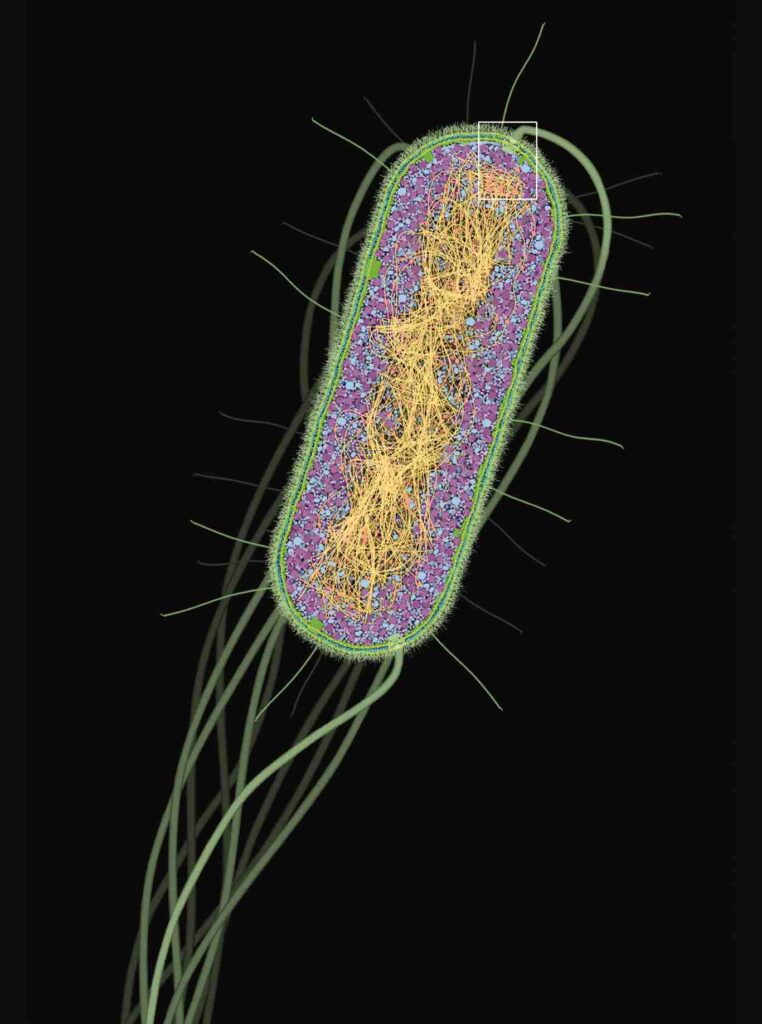
These disease-causing strains are called pathogenic E. coli, and they are responsible for a variety of illnesses, ranging from mild diarrhea to severe, life-threatening complications like hemolytic uremic syndrome (HUS).
Classification of Pathogenic E. coli Virotypes
Pathogenic E. coli strains are classified into several virotypes (pathotypes) based on their virulence mechanisms and the type of disease they cause. The major virotypes include:
- Enteropathogenic E. coli (EPEC)
- Enterotoxigenic E. coli (ETEC)
- Enteroinvasive E. coli (EIEC)
- Enteroaggregative E. coli (EAEC)
- Diffusely adherent E. coli (DAEC)
- Enterohemorrhagic E. coli (EHEC), also known as Shiga toxin-producing E. coli (STEC)
- Uropathogenic E. coli (UPEC)
- Neonatal meningitis E. coli (NMEC)
Each of these virotypes uses different virulence factors such as toxins, adhesins, and invasion proteins to cause illness.
1. Enteropathogenic E. coli (EPEC)

Characteristics:
- Commonly causes diarrhea in infants and children
- Attaches to intestinal cells and causes lesions called attaching and effacing (A/E) lesions
- Does not produce Shiga toxins
Virulence Factors:
- Bundle-forming pili (BFP) help initial attachment
- Locus of enterocyte effacement (LEE) contains genes for the type III secretion system
Transmission:
- Contaminated food or water
- Person-to-person in childcare settings
Symptoms:
- Watery diarrhea
- Vomiting
- Mild fever
- Abdominal cramps
At-risk Groups:
Infants, especially in developing countries
2. Enterotoxigenic E. coli (ETEC)
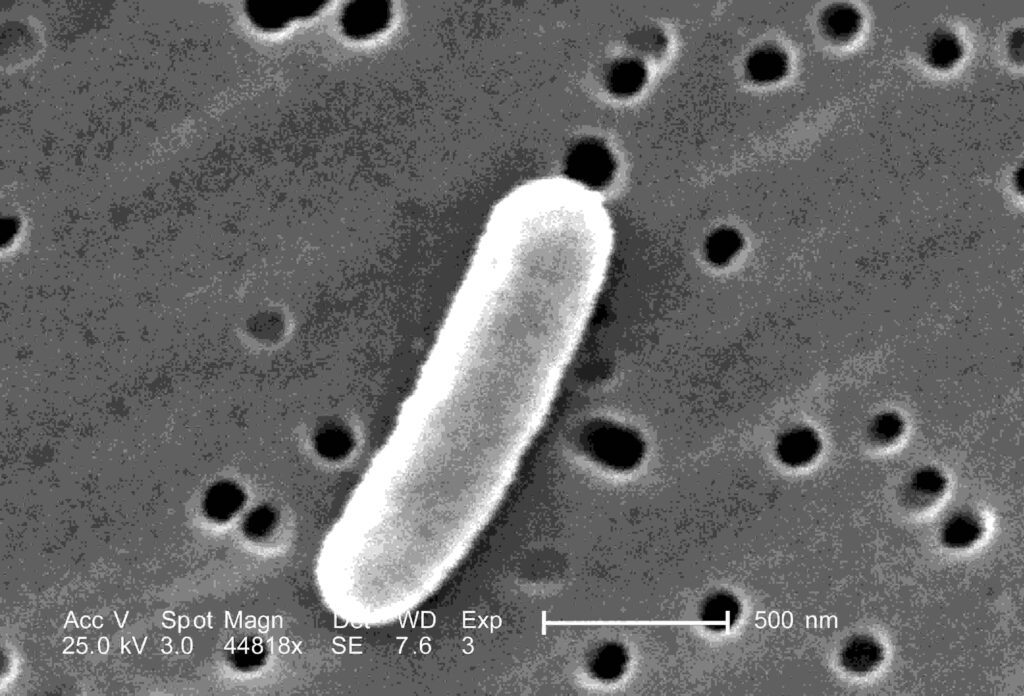
Characteristics:
- Leading cause of traveler’s diarrhea and diarrhea in children in developing countries
- Produces two toxins: heat-labile toxin (LT) and heat-stable toxin (ST)
Virulence Factors:
- LT and ST stimulate excessive secretion of fluids and electrolytes
- Colonization factors (CFs) help attach to the intestine
Transmission:
Consumption of contaminated food or water
Symptoms:
- Profuse watery diarrhea
- Nausea
- Mild cramps
- Low-grade fever
At-risk Groups:
- Travelers to tropical areas
- Children in poor sanitation areas
3. Enteroinvasive E. coli (EIEC)
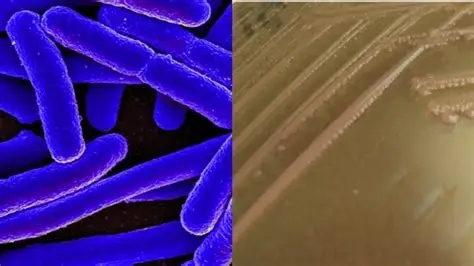
Characteristics:
- Invades intestinal epithelial cells and causes an illness similar to dysentery
- Similar in behavior to Shigella
Virulence Factors:
- Invasion plasmid antigens (Ipa) help in penetration and movement within cells
- Causes cell destruction and inflammation
Transmission:
- Fecal-oral route
- Contaminated food or water
Symptoms:
- Watery diarrhea that may become bloody
- Fever
- Severe abdominal cramps
- Mucus in stool
At-risk Groups:
All age groups, especially in outbreaks
4. Enteroaggregative E. coli (EAEC)
Characteristics:
- Adheres to intestinal cells in a “stacked brick” pattern
- Causes persistent diarrhea, especially in children and immunocompromised individuals
Virulence Factors:
- Aggregative adherence fimbriae (AAF)
- Enteroaggregative heat-stable toxin (EAST1)
- Pet cytotoxin
Transmission:
- Poor sanitation
- Contaminated food or water
Symptoms:
- Persistent watery diarrhea
- Low-grade fever
- Abdominal discomfort
- Dehydration if prolonged
At-risk Groups:
- Children in developing regions
- Immunocompromised individuals (e.g., HIV/AIDS patients)
5. Diffusely Adherent E. coli (DAEC)
Characteristics:
- Shows diffuse adherence on epithelial cells
- Less well understood than other virotypes
Virulence Factors:
- DAF receptor-binding adhesins
- Modifies host cell structure
Transmission:
Fecal-oral route
Symptoms:
- Watery diarrhea
- Mild abdominal pain
At-risk Groups:
Children aged 1–5 years
6. Enterohemorrhagic E. coli (EHEC) / Shiga Toxin-Producing E. coli (STEC)
Characteristics:
- Produces Shiga toxins (Stx1 and Stx2)
- Most common serotype is E. coli O157:H7
- Can cause severe complications like hemolytic uremic syndrome (HUS)
Virulence Factors:
- Shiga toxins inhibit protein synthesis in host cells
- Intimin and type III secretion systems for tight attachment
- LEE island
Transmission:
- Undercooked beef (especially ground beef)
- Unpasteurized milk and juice
- Raw vegetables and leafy greens
- Person-to-person contact
Symptoms:
- Bloody diarrhea (hemorrhagic colitis)
- Severe abdominal pain
- Vomiting
- Usually no fever
- Risk of HUS: a serious condition causing kidney failure, hemolytic anemia, and low platelets
At-risk Groups:
- Children under 5 years
- Elderly
- Immunocompromised people
7. Uropathogenic E. coli (UPEC)
Characteristics:
- Most common cause of urinary tract infections (UTIs)
- Ascends the urinary tract from the urethra to the bladder and kidneys
Virulence Factors:
- P fimbriae and type 1 fimbriae for adhesion
- Hemolysin and siderophores for iron acquisition
- Capsule and toxins for immune evasion
Transmission:
- Endogenous (from the person’s own intestinal flora)
- Sexual activity, catheter use
Symptoms:
- Burning sensation during urination
- Frequent urge to urinate
- Cloudy or bloody urine
- Pelvic pain
- Fever (if infection reaches kidneys)
At-risk Groups:
- Women
- Elderly
- Patients with urinary catheters
8. Neonatal Meningitis E. coli (NMEC)
Characteristics:
- Affects newborns
- Crosses the blood-brain barrier to cause meningitis
Virulence Factors:
- K1 capsule helps evade the immune system
- Invades brain endothelial cells
Transmission:
During childbirth from mother’s vaginal flora
Symptoms:
- Poor feeding
- Irritability
- Vomiting
- Bulging fontanelle
- Seizures
At-risk Groups:
Newborns (especially premature or low birth weight babies)
Food Poisoning by Pathogenic E. coli virotypes
Foods Commonly Contaminated:
- Undercooked ground beef
- Raw milk and dairy products
- Raw fruits and vegetables
- Apple cider
- Contaminated water
How Contamination Happens:
- Improper food handling or hygiene
- Animal feces in agricultural water or fields
- Cross-contamination in kitchens
- Poorly cooked meat
Incubation Period:
Usually 1 to 10 days, depending on virotype
Duration of Illness:
- Typically 3 to 7 days
- Can last longer in vulnerable individuals
Diagnosis of E. coli Infections
Laboratory Tests:
- Stool culture for isolation
- Serotyping (e.g., O157:H7 identification)
- PCR to detect virulence genes
- ELISA for Shiga toxin
- Urine culture for UPEC
- CSF culture for NMEC
Other Tests:
- Blood tests for signs of HUS (e.g., kidney function, platelet count)
- Imaging for severe infections
Treatment and Management
General Approach:
Most E. coli virotypes infections are self-limiting and do not require antibiotics
Supportive Care:
- Hydration with oral rehydration salts
- Pain management for abdominal cramps
- Diet: bland foods, avoid dairy and sugary drinks
Antibiotics:
- May be used for EPEC, ETEC, EAEC
- Not recommended for EHEC/STEC, as they may increase toxin release and risk of HUS
Hospitalization:
- For severe dehydration
- For HUS (may require dialysis)
- For systemic infections like meningitis or pyelonephritis
Prevention and Control
Food Safety Measures:
- Cook meat thoroughly (especially ground beef)
- Avoid raw milk and unpasteurized products
- Wash fruits and vegetables well
- Prevent cross-contamination in kitchens
Hygiene Practices:
- Wash hands with soap before eating and after using the toilet
- Keep kitchen surfaces clean
- Practice safe food handling during preparation
Traveler’s Tips:
- Drink only bottled or boiled water
- Avoid raw foods in areas with poor sanitation
- Carry oral rehydration salts
Public Health Actions:
- Surveillance of outbreaks
- Education about food safety
- Enforcement of food regulations
Public Health Significance
E. coli virotypes, especially EHEC/STEC, are responsible for numerous foodborne outbreaks around the world. These E. coli Virotypes outbreaks can cause serious illness, hospitalizations, and even death. Public health agencies monitor E. coli virotypes infections closely and often issue recalls of contaminated food products.
Notable Outbreaks:
- 1993: E. coli O157:H7 outbreak from Jack in the Box hamburgers in the USA
- 2011: E. coli O104:H4 outbreak in Europe (sprouts), causing HUS in many adults
- Multiple outbreaks linked to romaine lettuce, spinach, and ground beef
Conclusion
E. coli virotypes is a diverse group of bacteria with both harmless and harmful strains. The pathogenic E. coli virotypes can cause a range of illnesses, from mild diarrhea to severe and life-threatening conditions like hemolytic uremic syndrome and meningitis.
Understanding the different E. coli virotypes—EPEC, ETEC, EIEC, EAEC, DAEC, EHEC/STEC, UPEC, and NMEC—helps health professionals diagnose and treat infections appropriately. Equally important is the role of food safety, hygiene, and public health surveillance in preventing these infections.
From a simple bout of traveler’s diarrhea to a nationwide food recall, E. coli virotypes infections remain a major challenge that calls for awareness, proper hygiene, and scientific vigilance.
Three Key Summary of E. coli Virotypes
- Pathogenic E. coli virotypes cause a variety of diseases including foodborne diarrhea, urinary infections, and meningitis.
- The most dangerous type of E. coli Virotypes , EHEC/STEC (e.g., O157:H7), produces Shiga toxin and can lead to life-threatening HUS.
- Prevention relies on safe food handling, clean water, and personal hygiene practices.
FREQUENTLY ASKED QUESTIONS
What is the most dangerous E. coli virotype?
EHEC/STEC, especially E. coli O157:H7, is the most dangerous due to its ability to produce Shiga toxin and cause hemolytic uremic syndrome (HUS).
Can E. coli infections be treated with antibiotics?
Not always. Antibiotics are not recommended for STEC infections because they may increase the risk of complications. For other virotypes like ETEC or EPEC, antibiotics may be used in severe cases.
How does E. coli contaminate food?
Contamination occurs through fecal matter, poor sanitation, improper cooking, and cross-contamination during food preparation.
Related Articles

